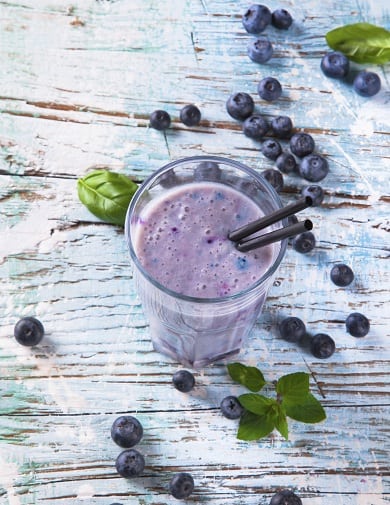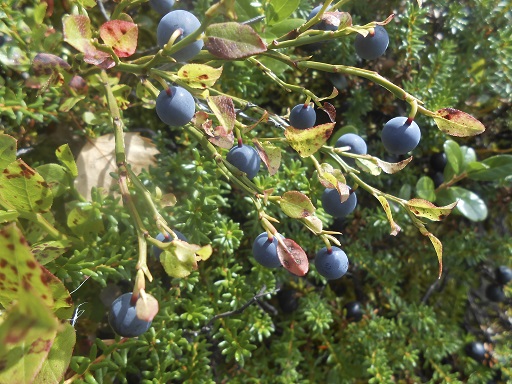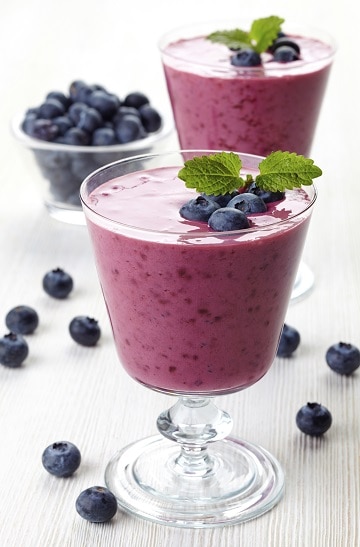Blueberries are one of the latest additions to the “superfood” club by the mainstream media, sitting alongside the likes of coconuts, broccoli and acai berries.
You may have heard sweeping statements that “blueberries are one of the greatest health foods of all time”, but you may have also heard easily disprovable lies such as “blueberries rank first on the list of 40 antioxidant fruits and vegetables”, when pomegranates and raspberries both rank higher.
With this article, I planned to explain the amazing acne-clearing superpowers of blueberries one by one, but the list ended up surprisingly short. Blueberries can lower LDL cholesterol and protect your delicate eye cells, but their greatest micronutrient for acne is vitamin C, with a measly 16% of the recommended daily intake.
One claim circulating the internet is that blueberries are a powerhouse of vitamin E, when they actually contain only 3% of the RDI. Blueberries have no unique powers such as the watermelon and its ability to heal old acne.
So should you gulp down the last blueberries in your fridge and convert to strawberries instead, which contain 97% of the RDI for vitamin C? Definitely not.
Calming the fires of red pimples
 Chronic inflammation is the root cause of acne, and it’s exactly what it sounds like – when a hyperactive immune system launches powerful inflammatory assaults against every cell in the human body.
Chronic inflammation is the root cause of acne, and it’s exactly what it sounds like – when a hyperactive immune system launches powerful inflammatory assaults against every cell in the human body.
This disease is plaguing millions of people today, causing heart disease, muscle pain and arthritis everywhere. It also leads to pimples, when an unrestrained immune response targets p.acnes bacteria and swells and reddens the surrounding skin pore.
Calming chronic inflammation should be your top priority, not taking hair-thinning accutane, and blueberries seem to be the perfect remedy:
ONE – some rats were fed wild blueberries AKA bilberries for 13 weeks, as either 5% or 10% of their diet. There was a sizeable reduction in pro-inflammatory responses, most notably chemicals called T helper type 1 cells. The scientists concluded that “Bilberries reduce the development of systemic inflammation and prevent the progression of chronic hypertension” (study)”.
Read Annihilate Your Acne – get the diet that could transform your skin!
TWO – 25 well trained athletes were fed 250 grams of blueberries every day for 6 weeks, and 375 grams approximately one hour before a 2.5 hour running session.
Compared to controls receiving a placebo, the blueberry crew enjoyed dramatically increased levels of an anti-inflammatory chemical called interleukin 10. Natural killer (NK) cells also increased, which despite their sinister sounding name, are generally anti-inflammatory inside the body.
It was concluded that “daily blueberry consumption for 6 weeks increases NK cell counts, and acute ingestion… increases anti-inflammatory cytokines” (study).
THREE – when topical blueberry was rubbed into inflamed rat paws at concentrations of 100mg, 200mg and 300m, swelling fell by 9.8, 28.5 and 65.9% respectively. Histamine was also measured, the notorious allergy chemical responsible for swelling, rashes, and indeed acne, and levels fell by 70.1, 71.7 and 81.9%.
The final battle was 300mg of blueberry versus methylperoxidase, a widely used biomarker of bloodstream inflammation. After 6 hours and 24 hours, levels plunged by 42.6% and 42.8%. The conclusion seemed to be tailor made for acne: “considering that the crude extract of blueberry displayed… anti-inflammatory activity, its consumption may be helpful for the treatment of inflammatory disorders” (study).
FOUR – rather than blueberries themselves, scientists tested two of their anthocyanin antioxidants: malvidin-3-glucoside and malvidin-3-galactoside. In blood vessels, they inhibited several notorious pro-inflammatory chemicals behind acne, including NFKappa-B and TNF-a. Malvidin-3-glucoside was particularly anti-inflammatory, but both anthocyanins performed well.
Next – the 6 best vitamins and minerals for naturally clear skin
Thus the conclusion: “blueberry is good resource of anti-inflammatory anthocyanins, which can be promising molecules… to prevent chronic inflammation in many diseases”. Could many diseases include acne? Absolutely (study).
The evidence is rock solid that by simply dining on blueberries and enjoying their classic flavour, you can calm the inflammatory chemicals behind acne.
A unique acne-clearing compound
Blueberries also contain an interesting chemical called pterostilbene, which shows tentative yet powerful properties against acne. In this article, we discussed the greatness of the red wine molecule resveratrol, how it inhibits the master molecule NF-KappaB that controls dozens of smaller inflammatory chemicals behind acne.
Well, the pterostilbene in blueberries is a close chemical analog of resveratrol. Its molecular structure is very similar, and like its cousin, pterostilbene has powerful anti-inflammatory effects when eaten (study). It can wipe away the chemical COX-2, while in another study, the inflammatory chemical TNF-a mysteriously disappeared.
7 acne-clearing topical treatments which are 100% natural
Better yet, pterostilbene has far superior absorption to resveratrol at 80% absorption in the gut compared to 20% for resveratrol (study). Its half life is seven times longer, persisting for 105 minutes versus 14 minutes, meaning that it exerts its healthy effects for longer.
Pterostilbene holds many secrets, and is also believed to inhibit a gene behind gut inflammation, which could help acne by curing food allergies and leaky gut syndrome.
This compound is still being furiously researched, which is somewhat unsurprising given the booming resveratrol supplement market. A supplement form has been patented and the market might well explode soon, but for you dear reader, there’s no need for patience: this compound is easily available in blueberries (and also grapes).
Blueberries clear acne via antioxidants
The second root cause of acne, meanwhile, is oxidative stress, when free radicals become massively elevated in the bloodstream and your antioxidant supplies get depleted as they ride to the rescue. Many individual antioxidants like vitamin E and vitamin A are vital for acne, particularly for preventing your sebum (oil) from mutating into a particularly comedogenic (pore-clogging) form called squalene peroxide.
Luckily, blueberries can prevent this from happening:
ONE: for 15 weeks, obese male rats were fed either a control diet or one with added blueberries. The former’s antioxidants evaporated, while the blueberry group enjoyed significantly reduced oxidative stress (study).
TWO: when applied to human muscle cells, blueberry extract displayed a “a potent and significant dose-dependent protective capacity” against oxidative stress (study). Like earlier, the antioxidants malvidin-3-glucoside and malvidin-3-galactoside were particularly strong, hinting that they’re two of blueberries standout natural compounds. The verdict was that blueberries prevent against muscle damage from free radicals – could skin damage be next?
Sea buckthorn oil – a natural secret for acne and oily skin
THREE: when fed to diabetic children, blueberries increased antioxidant levels, but particularly superoxide dismutase, an antioxidant which is found in some foods but is mainly manufactured by the human body itself. So as well as its own collection of antioxidants, blueberries might provide compounds which rev up your own antioxidant factories (study).
FOUR: 344 young male rats were treated with kainic acid and phosphate buffered saline (PBS), substances used in experiments to deliberately increase free radicals for testing (study). After 8 weeks, a 2% blueberry diet defended nicely against cognitive damage, with significantly less neuron loss and cognitive impairment.
FIVE: a simple yet great study, as when added to a meal, blueberries significantly increased the total antioxidant capacity of the bloodstream.
SIX: another meal study, this time demonstrating that the antioxidants in blueberries were highly bioavailable. Eating blueberries increased total bloodstream levels, including two specific antioxidants called caffeic acid and ferulic acid. Interestingly, adding milk to blueberries blunted this increase, but this clearly doesn’t occur with all foods; just look at study five.
Blueberries are nature’s very own antidote to oxidative stress. Pomegranates and blackberries are superior for antioxidants, but 100 grams of blueberries receives an ORAC score of 4669 while wild blueberries (bilberries) take it even further with 9100.
There’s a reason why blueberries taste so great, as it’s antioxidants which provide the rich flavours of fruits. If a fruit has a distinctive flavour, then that’s a sure signpost of some really distinctive antioxidants too.
Zinc – the mineral which can slash acne by up to 49.8%!
Among others, blueberries feature hydroxycinnamic acids like caffeic, ferulic, and coumaric acid, anthocyanins like malvidins, delphinidins, pelargonodins, peonidins and cyanadins, and flavanols such as kaempferol, quercetin, and myricetin. Many of these substances have unique powers for acne; quercetin, for example, is renowned for lowering gut inflammation and potentially all the acne that springs from it.
Myricetin may increase the uptake of glucose into energy stores, lowering blood sugar levels (less dead skin cells). Brazilians have used myricetin for type 2 diabetes for years now. The smattering of vitamin C is another bonus as it’s the most abundant water-soluble antioxidant in the human body.
Could blueberries end hormonal acne?
Blueberries may have one more hidden power for acne: regulating estrogen levels. The jelly portion in the centre of blueberries and blackberries is high in calcium d-glucarate, the same compound that gives oranges their estrogen-reducing benefits.
For women with estrogen dominance, lowering estrogen is excellent for oily skin, while for everyone else, more efficient metabolisation of estrogen by the liver can lower inflammation.
Whether whole blueberries possess these powers is unproven, but one study found that a 5% blueberry diet inhibited the breast cancer cells stimulated by estrogen. Another found that blueberries protected cells against the dangerous effects of uncontrolled estrogen, while leaving the beneficial effects intact.
How to make blueberries twice as acne-friendly
If you want to feast on the most acne-clearing blueberries that the planet has to offer, then organic is absolutely vital.
Conventional blueberries appear year after year on the “dirty dozen” list of most heavily sprayed foods. Whatsonymyfood.com has detected a staggering 52 agrochemicals on these blue fruits, as reported by the USDA Pesticide Data Program. That’s way beyond the conventional sweet potato, with only 9 agrochemicals detected.
Pesticides regularly sprayed on blueberries include…
- 8 known or probably carcinogens.
- 22 suspected hormone disruptors.
- 14 neurotoxins.
- 7 developmental or reproductive toxins.
It’s surprising that the average supermarket blueberry doesn’t burn a hole through your hand. If that sounds horrific, then the good news is that organic blueberries contain none of these nightmares. Pesticides unleash their acne mayhem by depleting the skin clearing antioxidant glutathione, which doubles up as a detoxification agent, but many pesticides can also generate free radicals directly. Others pile onto the acne inflammation dumping ground even at low levels.
Furthermore, organic blueberries are noticeably higher in acne-clearing antioxidants. This study on New Jersey blueberries detected significantly more phenolics, total anthocyanins, and antioxidant activity (as measured by ORAC) in those from organic fields. The following goodies were more abundant: myricetin 3-arabinoside, quercetin 3-glucoside, delphinidin 3-galactoside, delphinidin 3-glucoside, delphinidin 3-arabinoside, petunidin 3-galactoside, petunidin 3-glucoside, and malvidin 3-arabinoside. Basically, every acne-clearing substance you could dream of.
The bottom line was 50% higher total antioxidants, and another study was similar excellent: anthocyanins, phenols and total antioxidants were all higher in organic blueberries, as were individual antioxidants like quercetin.
It’s clear that if you’re a clear skin disciple, or a health fanatic, organic blueberries are the only way to go.
The best option ever is organic wild blueberries (which are technically always organic), known as bilberries, as their ORAC score of 9100 blows the blueberries 4669 right right of the water. You can see their picture above.
Get the eBook – learn why eating fish can improve acne by 42%
Additionally, here’s one more nugget of wisdom: there’s a common misconception that freezing blueberries depletes the acne nutrients, but one study found no significant depletion in anthocyanin content after several months in the freezer.
If one day, your dreams come true and you stumble into the magical blueberry forest, feel free to pick as many as you like, freeze them solid and build up a massive supply.
Conclusion – a top third fruit for acne
Blueberries are a tasty and effective weapon for making your acne history, via lowering inflammation and banishing oxidative stress.
If you’ve long been a blueberry fan, then your time has come. It’s smartest to combine your blueberries with a variety of acne-curing power, such as Brazil nuts for selenium, strawberries for their supreme content of vitamin C, and garlic for their secret digestive benefits. The contenders in this world of acne cures are endless.
The blueberry shows us how once again, the cures for acne are staring us in the face. You don’t need antibiotics, you don’t need BP, and you certainly don’t need mental problems with accutane. Anti-inflammatory foods and natural acne supplements can be found everywhere.
If you wish to get started right now, then read this article about simple dietary strategies for acne.
The bottom line: blueberries are easily in the top third of fruits for acne.
NEXT: discover the root causes of acne and banish your pimples forever
Thanks for reading!



